
Director Jeremy Lelliott works wonders with Tony Kushner’s A Bright Room Called Day, turning a play that in other hands might seem stuffy or talky or dated into an exciting, utterly relevant evening of theater.
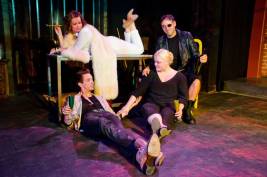 Set in Berlin in the months between January 1, 1932 and November 12, 1933, A Bright Room Called Day focuses on a semi-successful German film actress and her circle of left-leaning friends—a glamorous movie starlet, a gay man, an artist, a cinematographer, and a pair of communist party functionaries.
Set in Berlin in the months between January 1, 1932 and November 12, 1933, A Bright Room Called Day focuses on a semi-successful German film actress and her circle of left-leaning friends—a glamorous movie starlet, a gay man, an artist, a cinematographer, and a pair of communist party functionaries.
With the Weimer Republic faltering and Adolph Hitler and his Nazi Party rising in power, Agnes Eggling and her bohemian chums find themselves increasingly threatened by the events unfolding around them, ultimately reaching a point where escape seems the only solution, albeit one fraught with dangers of its own.
Scenes in Kushner’s written text vary in tone and power.
Friends discuss politics, hardly the stuff of great drama. (“But there isn’t going to be a revolution.” “Oh yes there is!” “He said there wasn’t.” “Well, he’s wrong.”)
The play’s numerous soliloquies are written as poetry, i.e. easy to zone out of. (“This Age wanted heroes./It got us instead:/carefully constructed, but/immobile. /Subtle, but/unfit/to take up/the burden of the times./It happens./A whole generation of washouts./History says stand up,/and we totter and collapse,/weeping, moved, but not/sufficient.”)
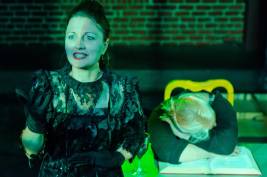 An old lady Kushner dubs Die Alte materializes inside Agnes’s apartment (or her dreams) with her own mystifying words. (“When the tree is black and bare,/And the barren branches droop,/Don’t go to the kitchen where/The penny man makes poison soup.”)
An old lady Kushner dubs Die Alte materializes inside Agnes’s apartment (or her dreams) with her own mystifying words. (“When the tree is black and bare,/And the barren branches droop,/Don’t go to the kitchen where/The penny man makes poison soup.”)
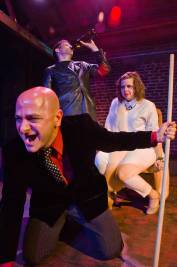 Even the Devil himself pops by, summoned from his Hungarian lair by Agnes’s expatriate cinematographer friend.
Even the Devil himself pops by, summoned from his Hungarian lair by Agnes’s expatriate cinematographer friend.
On a far more positive note, many scenes (particularly those in the second act) are as gripping as it gets.
One character must consider whether to star in films made for the Third Reich or emigrate to Hollywood or Russia. Another, arrested for no other reason than his homosexuality, realizes the danger he faces should he stay in Germany. A third is attacked by fascist thugs and nearly killed. And Agnes, coerced into risking her life for the anti-Nazi underground, must decide whether to follow her friends into exile or to stay in Berlin and hope simply to survive.
Premiering several years before Kushner’s Pulitzer Prize-winning Angels In America and at the height of the AIDS epidemic, A Bright Room Called Day has included in most of its stagings a contemporary character named Zillah, there in order to connect the events of the early ‘30s with the Reagan ‘80s. (Kushner was one of Ronald Reagan’s fiercest critics for having waited six-and-a-half years into the epidemic to even mention AIDS in a public forum.)
Director Lelliott opts to take Kushner up on one of the staging options offered in the playwright’s production notes, that of doing the play without Zillah, and the result is, as Kushner has suggested, a play that is “less difficult” and “less likely to freak out critics.”
A Zillah-less play would, however, leave the play entirely “in the past,” a result which Lelliott manages to avoid with two ingenious moves.
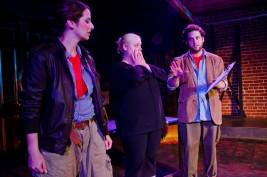 The first has been to cast the play young. Kushner’s core characters are written in their mid-thirties to mid-forties. Lelliott’s Coeurage players are about a decade their junior, and if a certain credibility is sacrificed in making them younger, audiences in that age group will find it considerably easier to identify with Agnes and her friends—and see their problems as relevant to their own lives—than had they been cast as written.
The first has been to cast the play young. Kushner’s core characters are written in their mid-thirties to mid-forties. Lelliott’s Coeurage players are about a decade their junior, and if a certain credibility is sacrificed in making them younger, audiences in that age group will find it considerably easier to identify with Agnes and her friends—and see their problems as relevant to their own lives—than had they been cast as written.
Even more significantly, Lelliott has chosen to replace Zillah’s scenes with a series of striking dance sequences performed by the cast and choreographed by Carly Wielstein to alternative rock/metalcore/indie pop/electro swing/indie folk/new wave/reggae fusion/indie rock tracks by Fun, Kat Edmonson, iwrestledabearonce, Caravan Palace, Mumford & Sons, Elvis Costello, Matisyahu, Tom Waits, and Tally Hall. Not only are these dance sequences gorgeously executed, Wielstein’s inspired choreography evokes past events with moves as contemporary as those you’d see in any modern dance concert.
(Lelliott has managed to find a way to leave in one of Zillah’s most powerful commentaries, in which she poses the question: Can anything now qualify as Evil with a capital E when compared to the ultimate Evil of The Holocaust?)
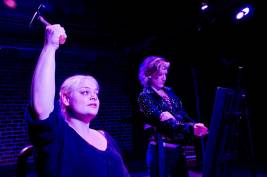 Teya Patt’s powerful, richly authentic work as Agnes Eggling anchors A Bright Room Called Day in reality and serves as our conduit into the lives of the characters surrounding her. Patt’s rendition of Mack The Knife à la Lotte Lenya is breathtaking, as are Agnes’s final moments alone on stage.
Teya Patt’s powerful, richly authentic work as Agnes Eggling anchors A Bright Room Called Day in reality and serves as our conduit into the lives of the characters surrounding her. Patt’s rendition of Mack The Knife à la Lotte Lenya is breathtaking, as are Agnes’s final moments alone on stage.
Erin Anderson, Nicole Monet, and Miles Warner give powerful performances as communist artist Annabella Gotchling, film goddess Paulinka Erdnuss, and Hungarian cinematographer Vealtninc Husz. Kim Reed and Bert Rotundo are splendid as the otherworldly Die Alter and Herr Swetts (aka Satan himself). Mark Jacobson and Laura Crow do forceful work in the smaller roles of communist party functionaries Rosa Malek and Emil Traum.
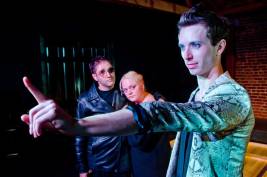 Best of all supporting players is Graham Kurtz, unforgettably, heartbreakingly real as gay Berliner Gregor “Baz” Bazwald, whose life would be equally in danger in today’s Russia. (Could A Bright Room For Day be any more relevant to current events, specifically to the draconian anti-gay laws now threatening the livelihoods and even the lives of LGBT Russians?)
Best of all supporting players is Graham Kurtz, unforgettably, heartbreakingly real as gay Berliner Gregor “Baz” Bazwald, whose life would be equally in danger in today’s Russia. (Could A Bright Room For Day be any more relevant to current events, specifically to the draconian anti-gay laws now threatening the livelihoods and even the lives of LGBT Russians?)
I can’t rave enough about a) Tito Fleetwood Ladd’s production design, especially his giant mural evoking events and personages in 1930s Germany and Russia; b) Joseph V. Calarco’s dramatic sound design and its music tracks in particular; and c) Cole Clemens’ terrific costumes, whose retro-contemporary look proves ideal for Lelliott’s vision.
Kudos also to Gregory Nabours for his as always pitch-perfect musical direction. (In addition to Patt’s solo, the cast sing an exquisite a cappella rendition of The Tremeloes’ “Silence Is Golden” and Monet an equally lovely “Memories Of You” à la Rosemary Clooney.)
Ryan Wagner scores points for his excellent dialect coaching, though having Die Alte speak with a thick German accent proves a questionable directorial choice considering that every other German speaks American-accented English.
TJ Marchbank wears a pair of hats to perfection—those of fight choreographer and video/projection designer. Kushner’s chillingly dry facts flash across Ladd’s mural with increasing impact, while black-and-white snapshots of a smiling Hitler and his Nazi cohorts get followed by horrifying images of concentration camp atrocities and later by slides depicting great acts of anti-Nazi heroism.
Megan Laughlin is stage manager, Sammi Smith is assistant director, and Kate Grabau is stage manager/dance captain.
Understudies James Ferrero, Grabau, Connor Kelly-Eiding, Abigail Marks, Jeffrey Masters, Kyle David Pierce, Deven Simonson, and Joe Nicole Thomas will appear at certain performances.
If A Bright Room Called Day is only rarely revived, it is doubtless due to a problematic nature acknowledged even by the playwright, making its current revival a gutsy move from arguably L.A.’s finest young theater company. That Lelliott and his Coeurage Theatre Company team have succeeded with power and punch is testimony to their many gifts. If Tony Kushner could make it out to see this daringly innovative look at A Bright Room Called Day, I think he’d be pleased indeed.
Reviewer’s note: Coeurage Theatre is “Los Angeles’ only pay-what-you-want theatre.” (They’ve even trademarked the slogan.) No one will be turned away for lack of big bucks, however those with deep pockets will likely be more than happy to dig deep.
The Lost Studio, 130 S. La Brea Avenue, Los Angeles.
www.coeurage.org
–Steven Stanley
August 17, 2013
Photos: Kevin McShane
Tags: Coeurage Theatre Company, Los Angeles Theater Review, Tony Kushner


 Since 2007, Steven Stanley's StageSceneLA.com has spotlighted the best in Southern California theater via reviews, interviews, and its annual StageSceneLA Scenies.
Since 2007, Steven Stanley's StageSceneLA.com has spotlighted the best in Southern California theater via reviews, interviews, and its annual StageSceneLA Scenies.







 COPYRIGHT 2025 STEVEN STANLEY :: DESIGN BY
COPYRIGHT 2025 STEVEN STANLEY :: DESIGN BY